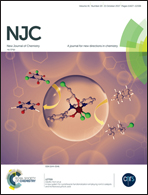Design and construction of a new optical solid-state mercury(ii) sensor based on PVC membrane sensitized with colloidal carbon dots
Abstract
A new Hg2+ ion solid-state double layer sensor impregnated with colloidal carbon dots and N′-(3-(4-(dimethylamino)phenyl)allylidene)isonicotinohydrazide (NDPAI, as a second layer) was inserted in plasticized polyvinyl chloride (PVC) as the first layer. Dibutyl phthalate (DBP) provides the best conditions for cation exchange, while sodium tetraphenylborate (NaTPB) restricts anionic co-extraction and improves sensor performance. This portable and facile solid state sensor was characterized via field emission scanning electron microscopy (FE-SEM) and atomic force microscopy (AFM). The maximum wavelength corresponding to the absorbance at 381 nm in the absence of Hg2+ ions shifted to 510 nm following the addition of Hg2+ ions, which indicates the formation of a complex of NDPAI and the colloidal carbon dots with mercury(II) ions. Optimization of variables (amount of ionophores and ionic additives and plasticizer/PVC weight ratio) and their contribution to sensor response were investigated by a central composite design (CCD) coupled with the desirability function approach (DFA); accordingly, the best operation conditions were set as 3 mg, 3.5 mg and 1.5 for the ionophore, ionic additive (NaTPB) and plasticizer/PVC weight ratio, respectively. Studies showed that the sensor has a linear response over 7.8 × 10−7 to 2.83 × 10−5 mol L−1 with a limit of detection of 4.65 × 10−7 mol L−1. Due to its good analytical figures of merit, such as acceptable repeatability (RSD = 1.03%), reproducibility (RSD = 4%) and reasonable lifetime, this sensor is a potential candidate for real applications. The sensor was applied in different water samples, with acceptable recovery for the determination of Hg2+ in the presence of conventional interfering ions, such as Cu2+, Pb2+ and Ni2+ ions.



 Please wait while we load your content...
Please wait while we load your content...